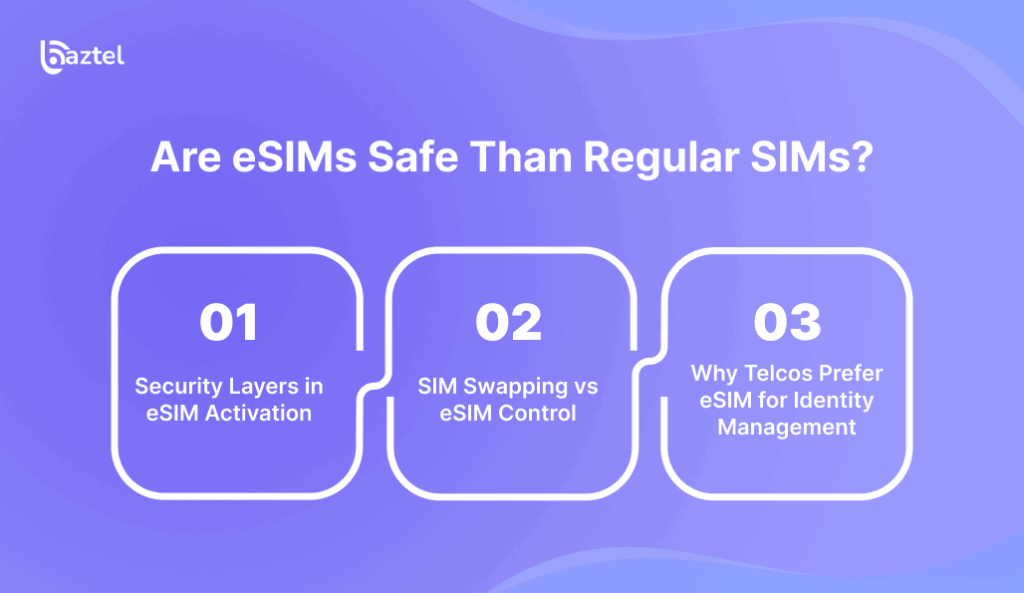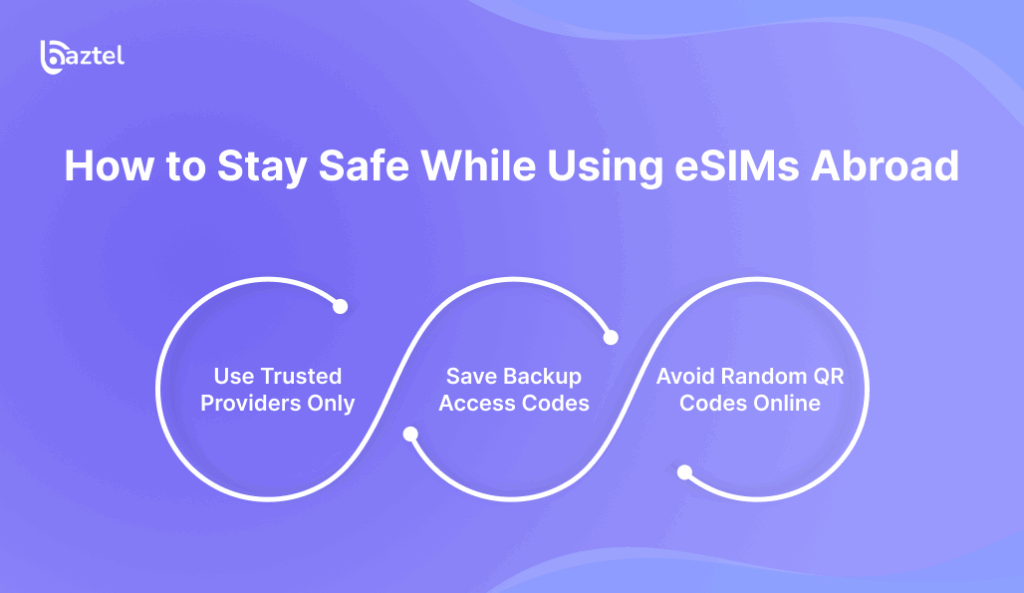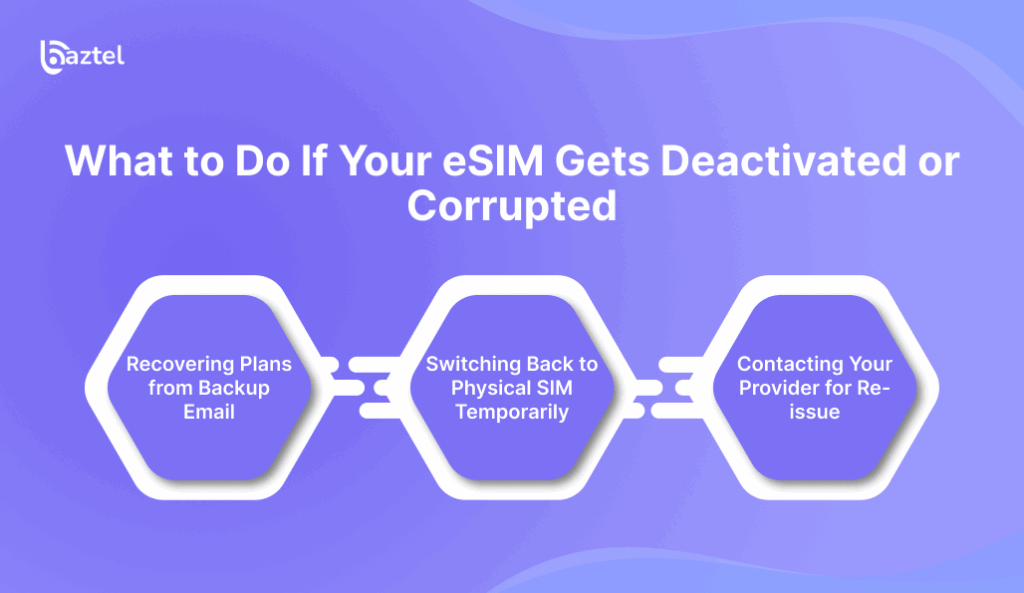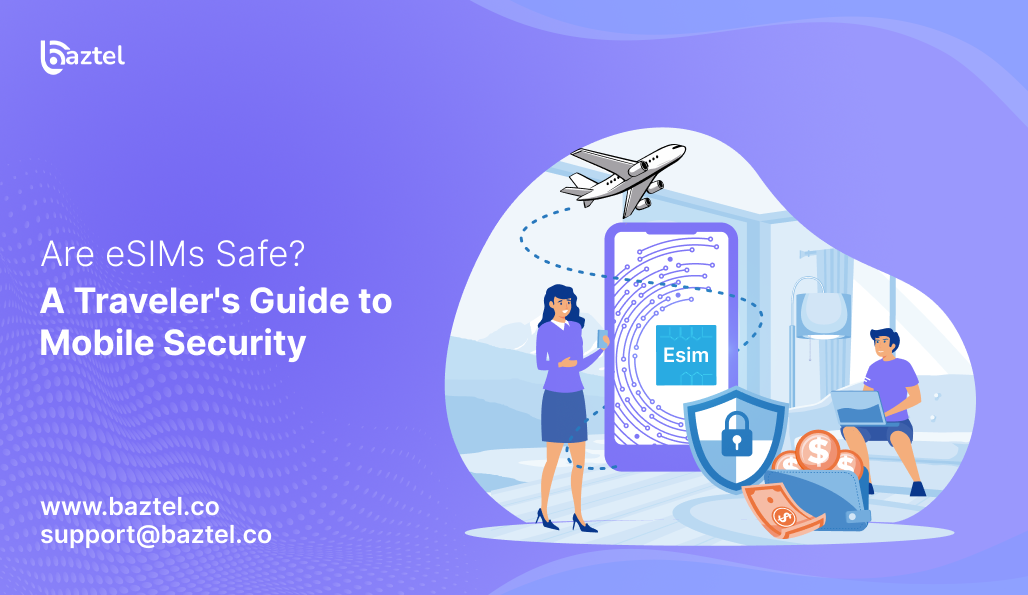If you’re planning your next trip and wondering, “Are eSIMs safe?” — you’re not alone. Many travelers switching from physical SIMs to eSIMs still have doubts about hacking, privacy, or security risks. And honestly, it’s a fair concern. You’re putting your mobile identity into a chip you can’t even touch.
But here’s the thing: eSIM technology is not just about convenience anymore. It’s become a security upgrade too — if you know how to use it right.
In this blog, we’ll break down how eSIM works, what risks travelers should be aware of, and simple steps you can take to protect your phone, data, and identity while abroad. From QR codes to backup issues — everything’s explained in plain English.
And if you’re new to how this all works, you can also check out our basic guide on what is an eSIM and how it works before moving ahead.
What is an eSIM and How Does It Work?
An eSIM, short for embedded SIM, is a tiny chip built directly into your smartphone, tablet, or even laptop. Unlike traditional SIM cards that you insert manually, eSIMs are activated digitally through QR codes or app-based profiles. You don’t need to visit a store, carry multiple SIM cards, or worry about losing them while traveling.
With eSIM, you can instantly switch mobile networks, activate data plans, or store multiple profiles — all without touching a physical card.
eSIMs are especially popular among travelers who want to avoid roaming charges or language barriers at foreign telecom stores. And since the chip is non-removable, it also adds an extra layer of security when your phone is lost or stolen.
Before we move into how safe they are, let’s quickly look at why travelers are switching to eSIMs in the first place.
How It’s Different from a Physical SIM
A physical SIM is a tiny card you insert into a phone. You remove it, swap it, or sometimes lose it. An eSIM, on the other hand, is built into your device. It can’t be removed. You activate it using a QR code or through a mobile app.
This change makes life easier. No more searching for SIM ejector pins or standing in line at airports to buy a local SIM. You can switch plans from anywhere — airport lounge, hotel room, or café — without needing any tools.
Another major difference is how it connects. With physical SIMs, telcos store user identity on the card. But with eSIMs, your identity is stored and managed remotely using encrypted networks. That gives providers more control — and adds more security layers.
You’ll also find that eSIMs allow multiple profiles, so you can keep your home number active while using a travel plan on the same device — especially useful for people using dual-SIM iPhones.
Why Travelers Are Switching to eSIMs
Most travelers are done carrying multiple SIM cards or rushing to buy a local one after landing. With eSIMs, you can activate a data plan before you even board the flight. That means instant internet the moment you arrive — no airport kiosks, no language barriers, no waiting.
Another reason? No need to physically handle the SIM tray. For people using waterproof phones or iPhones without SIM slots (like newer iPhone models), eSIM is the only option.
Cost is also a big reason. Many providers like Baztel offer affordable international plans — often cheaper than traditional roaming. You also get clear data limits and validity, unlike surprise charges with roaming.
For digital nomads and frequent flyers, being able to switch between multiple eSIM profiles — like one for Europe and one for Asia — is a game-changer. And if you’re planning trips across countries, you’ll find eSIM for Europe or eSIM for Asia extremely handy.
Are eSIMs Safe to Use in 2025?
When something goes digital, safety is the first question people ask — and that’s fair. With eSIMs, many travelers wonder: Can this chip really be trusted with my data, identity, and network connection?
The short answer: Yes, eSIMs are safe — but only if you’re careful. eSIM technology follows GSMA security standards, the same global body that oversees mobile network safety worldwide. These standards ensure your eSIM profile can’t be easily copied or transferred without your consent.
But that doesn’t mean there’s zero risk. If your phone is stolen, or you scan a fake QR code from an untrusted source, things can go wrong. That’s why we’ll break down the real risks, the safe practices, and the myths you can ignore — especially if you’re using free trial eSIMs or switching between plans.
By the end of this guide, you’ll know how to protect your mobile identity — whether you’re backpacking across Europe or working remotely in Japan with country-specific eSIMs.
Can Someone Hack an eSIM?
Technically, yes — but not in the way most people fear.
eSIMs are harder to hack than physical SIM cards. Why? Because they don’t pop out. There’s no physical access, no tray, no SIM-swap scam that happens in 2 minutes at a mobile shop. Every profile is digitally signed and verified by your provider, making unauthorized access extremely difficult.
That said, eSIM hacking attempts have evolved. Some cybercriminals now target your email, QR code, or provider account instead. If they get access there, they might trigger a remote reset or profile reactivation on another device.
To stay safe, always:
- Use strong email passwords
- Avoid saving QR codes in your gallery
- Don’t click suspicious links sent by strangers
If you’re switching between devices often, learn how to transfer your eSIM safely. And if you suspect foul play, contact your eSIM provider immediately.
You can also read our eSIM Security Guide for a deeper look into how providers secure your data.
What Happens If You Lose Your Phone?
Losing your phone while abroad is stressful. But with an eSIM, the worry shifts — your number and plan aren’t gone, they’re still linked to your account.
Unlike physical SIMs, eSIMs can’t be pulled out and misused instantly. But if your phone falls into the wrong hands, someone could still access apps, OTPs, or payment info — especially if your device isn’t locked properly.
Here’s what you can do immediately:
- Use Find My iPhone or Find My Device to lock or erase your phone remotely.
- Inform your eSIM provider to deactivate the eSIM profile. You can later reactivate it on a new phone.
- If your travel SIM is from Baztel or similar, recovery is easy via email. Here’s how to restore your eSIM profile.
Also, always set a strong screen lock, enable 2FA on cloud backups, and save your eSIM QR code backup in a safe place.
Travel smart. Even if your device is lost, your eSIM can stay secure and recoverable.
Are Public QR Codes Risky?
Yes, they can be — especially for eSIMs.
When you’re at airports, public kiosks, or online forums, you might come across QR codes that promise free data or fast activation. But here’s the problem: you don’t know who created them.
A malicious QR code can:
- Install a fake eSIM profile that tracks your data.
- Link you to a scam site asking for payment or ID details.
- Cause errors in your phone’s network settings.
Many new travelers unknowingly scan public codes shared in Telegram groups or Reddit threads — and later face issues like network loss, plan misuse, or phone errors.
To avoid this, always:
- Get your eSIM QR code directly from the provider’s website or verified app.
- Cross-check provider names. For example, Baztel eSIM only sends codes via email or its official dashboard.
- If unsure, use manual activation steps instead of scanning anything random.
QR codes are convenient — but when it comes to travel connectivity, safety should come first.
Are eSIMs Safe Than Regular SIMs?

A lot of travelers ask this. And the short answer is — yes, in most cases.
Let’s break it down by looking at what makes eSIMs more secure than physical SIM cards, especially in 2025.
Security Layers in eSIM Activation
When you insert a physical SIM, your phone just reads it — no questions asked. But with eSIMs, you need to go through an activation process.
This includes:
- Scanning a verified QR code
- Entering a unique activation key
- Device lock-in (eSIM is tied to one IMEI)
Some providers like Baztel also add extra steps like email OTP or dashboard verification. That means, even if someone gets your QR code, they can’t activate it without your login.
Want to try a safe plan? Check eSIM for Germany or eSIM for Japan — both countries have strict digital security standards and trusted local networks.
SIM Swapping vs eSIM Control
SIM swapping is when a scammer pretends to be you and convinces the telecom company to issue a new SIM. This lets them access your OTPs, bank alerts, and social accounts.
But here’s where eSIM wins:
- No physical card to clone or replace
- Most providers require re-verification for re-issuance
- Many eSIMs are linked to your phone’s IMEI, so switching is harder
So if you’ve ever been worried about someone hijacking your number, eSIM gives you more control and peace of mind.
You can also explore eSIM for South Korea — one of the safest destinations for digital travelers.
Read our full guide on eSIM security to understand how this works in real scenarios.
Why Telcos Prefer eSIM for Identity Management
Telecom companies around the world are slowly moving to eSIM-only models — especially for security reasons.
With eSIM:
- They can verify users digitally
- Lock profiles to a single device
- Monitor changes in real time
Physical SIM cards are easy to toss or resell. eSIMs, on the other hand, leave a digital trail that makes fraud detection easier.
For example, in Singapore, most major carriers already offer eSIM by default. And in France, digital ID verification is built into most plans.
That’s why more and more countries are encouraging users to shift to eSIM — not just for convenience, but for safer digital identity.
What Data Does an eSIM Store Have?
An eSIM may look like a simple digital chip, but behind the scenes, it carries important security data tied to your identity and usage.
Let’s explore what gets stored and what doesn’t — especially when you’re using it during international travel.
Does It Track Your Location?
No, the eSIM itself doesn’t store or track your GPS location.
However, your mobile network provider can always estimate your location — just like with a physical SIM — based on the nearest cell tower you’re connected to. This is standard in almost every country.
That said, some countries have stricter rules on data privacy. For example, if you’re traveling to Italy or Spain, local telcos follow the EU’s GDPR policy. That means:
- No third-party data sharing
- You’re notified if your data is used for verification
- You have the right to erase or request it
So while your eSIM connects you to a local network, location data stays between you and your provider — not with the eSIM itself.
Can Someone Clone an eSIM?
This is a common concern, especially with digital tech. But here’s the good news:
Cloning an eSIM is far more difficult than cloning a physical SIM.
Why?
- eSIMs are locked to your device’s IMEI
- QR codes are one-time-use only
- Some providers like Baztel generate unique activation keys for each plan
- Telcos in secure regions (like France or South Korea) require OTP re-verification before profile transfer
Even if someone gets your QR code, they can’t activate it again without your device or credentials.
This makes eSIM cloning extremely rare — and highly traceable if it ever happens.
Do Travel eSIMs Compromise Your Privacy?
Travel eSIMs are easy to activate, often cheap, and promise instant connectivity. But the real question is — are they safe for your data and privacy?
Let’s look at what smart travellers need to know before using one abroad.
Are Free eSIMs Trustworthy?
Not always.
While free trials sound tempting, some shady providers harvest your personal data in exchange for offering free eSIMs. This is more common on random websites or apps that don’t disclose who they are.
If you’re visiting countries like Japan or Germany, stick to licensed eSIM providers that:
- Offer clear privacy policies
- Avoid third-party data sales
- Let you delete data when the trip ends
Avoid downloading eSIMs from unknown sources or Telegram groups. You don’t know where your data ends up.
What to Check Before You Install One
Before installing any eSIM profile, make sure you:
- Verify the domain (avoid URLs that look spammy or unofficial)
- Check the provider’s customer reviews (especially for countries like Singapore or Turkey)
- Confirm if they encrypt your data during activation
- Make sure they don’t ask for unnecessary permissions (like access to your photos or contacts)
Baztel, for instance, doesn’t ask for any KYC in most regions, including Thailand and Australia. That’s a green flag.
Your eSIM should connect you, not track you.
How to Stay Safe While Using eSIMs Abroad

Traveling with an eSIM is convenient — but if you’re not careful, your data or connectivity could be at risk. Whether you’re roaming through France, working remotely in South Korea, or island-hopping across Greece, here’s how to keep your eSIM experience smooth and secure.
Use Trusted Providers Only
Avoid deals that feel too good to be true. Always choose verified providers with global reach and clear refund or support policies. For example, if you’re traveling to Canada or Spain, Baztel lets you activate your plan in minutes — without shady terms or hidden apps.
Trusted providers also let you switch plans if your network fails mid-trip. That’s a big plus.
Save Backup Access Codes
Most eSIM providers, including Baztel, email you a QR code and manual setup details. Save them somewhere offline — maybe in your notes app, a secure password manager, or just take a screenshot and lock it in a gallery vault.
If your phone resets or you switch devices during your trip to UAE or Singapore, you’ll thank yourself for saving that QR code.
Avoid Random QR Codes Online
Do NOT scan eSIM QR codes from social media, Telegram, Reddit, or websites you don’t fully trust. Some fake QR codes are designed to redirect you to phishing sites or force install unwanted profiles.
Especially in high-traffic tourist countries like Italy or Thailand, stick to provider websites or apps. Double-check the URL before scanning anything.
What to Do If Your eSIM Gets Deactivated or Corrupted

Even though eSIMs are more secure than physical SIMs, glitches can still happen. Your QR code might not work after a reset, or a software update could temporarily disable the plan. If something like this happens while you’re in Australia, Germany, or Turkey, don’t panic — here’s how to fix it fast.
Recovering Plans from Backup Email
Most providers send a confirmation email after purchase. This email usually contains your QR code, manual setup details, or a login link to your plan dashboard. If you’re stuck in Japan or Dubai, open your email app, search for the provider’s name, and re-download the setup info. This step works in most cases.
Switching Back to Physical SIM Temporarily
If you’re unable to restore your eSIM instantly, insert your physical SIM to get temporary access. Just make sure roaming is turned off to avoid high charges. This is helpful in countries like South Korea or France, where local data is essential for maps and messages.
Once your eSIM issue is fixed, switch back from Settings.
Contacting Your Provider for Re-issue
Good providers like Baztel offer 24/7 support — even during your trip. If your eSIM was corrupted while in Indonesia or UK, open their chat or email the support team. They’ll usually send you a fresh QR code after verifying your order ID or email address.
Always contact the support team directly — never via third-party Telegram groups or random links.
Conclusion
Traveling in 2025 comes with smarter gadgets, faster networks, and new security risks. eSIMs offer one big advantage: they remove the need to carry tiny SIM cards that can be lost, cloned, or misused. But just because they’re digital doesn’t mean they’re immune to problems.
If you’re using an eSIM for travel, make sure you’re buying from a trusted source like Baztel. Avoid shady free trials or unverified QR codes found online. Always check if your device is eSIM compatible, especially if you’re switching between iPhone, Android, or even laptop setups.
Remember: safety isn’t just about technology. It’s also about how smartly you use it. Just like you wouldn’t connect to any random Netflix account on public WiFi, don’t trust every QR code claiming to offer “free global data.” The best security comes from a mix of strong tech and good habits.
If you’re planning a trip, browse our country-wise eSIM plans and travel with peace of mind.
FAQs
Q. Is an eSIM safe to use while traveling internationally?
Yes. In fact, eSIMs are safer than physical SIMs in many cases. Since they’re built into your device, no one can remove or swap them without your permission. You just need to buy from a trusted provider like Baztel.
Q. Can someone hack my eSIM or steal my number?
It’s very rare. eSIMs have strong digital protections. But avoid downloading plans from random QR codes or unknown sources. Stick to verified sellers and official websites.
Q. What if I lose my phone with an active eSIM inside?
You can still contact your provider to block the eSIM or reissue the profile on another phone. It’s like blocking a stolen debit card. Always keep your email and backup code handy.
Q. Are free eSIM plans from unknown sites safe to install?
No. Many free plans online can be fake or insecure. They may misuse your data or not work at all. It’s better to pick plans from providers with real support and clear terms.
Q. Is it safe to use eSIMs on public WiFi or in countries like China or Turkey?
Yes, but be cautious. Public WiFi can expose any data, not just your eSIM. Use a VPN if you’re in countries with strict internet rules. And always turn off unused profiles when not needed.
Blog Author
Peter
Peter started BazTel.co to make mobile internet easier for travellers. He noticed how tough it was to find good network options while visiting new countries. That’s when he built BazTel — a place where anyone can buy eSIMs online without confusion or long steps. He believes tech should be simple and useful, not complicated. When he’s free, he likes to travel, test BazTel himself, and keep improving it based on real user problems.

 Botswana
Botswana Zambia
Zambia Congo
Congo Colombia
Colombia China mainland
China mainland Chile
Chile Chad
Chad Central African Republic
Central African Republic Canada
Canada Cameroon
Cameroon Cambodia
Cambodia Burkina Faso
Burkina Faso Bulgaria
Bulgaria Brunei Darussalam
Brunei Darussalam Brazil
Brazil Aland Islands
Aland Islands Bosnia and Herzegovina
Bosnia and Herzegovina Bolivia
Bolivia Belgium
Belgium Belarus
Belarus Bangladesh
Bangladesh Bahrain
Bahrain Azerbaijan
Azerbaijan Austria
Austria Australia
Australia Armenia
Armenia Argentina
Argentina Algeria
Algeria



